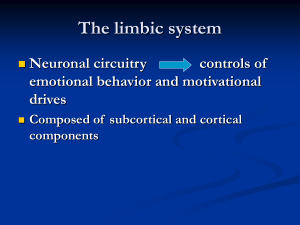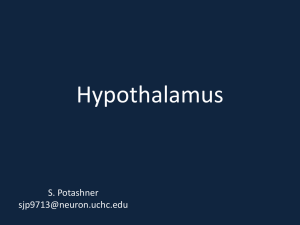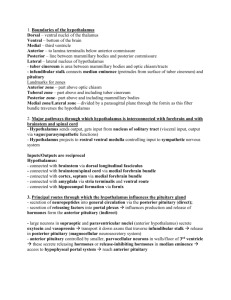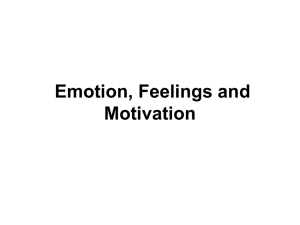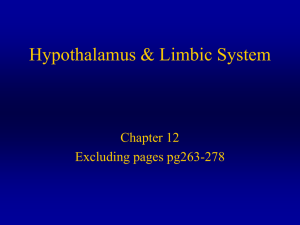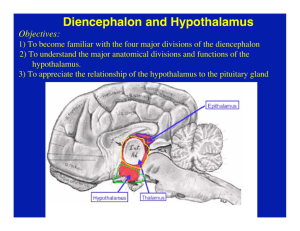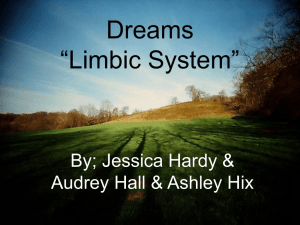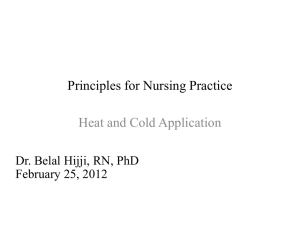Hypothalamus
advertisement
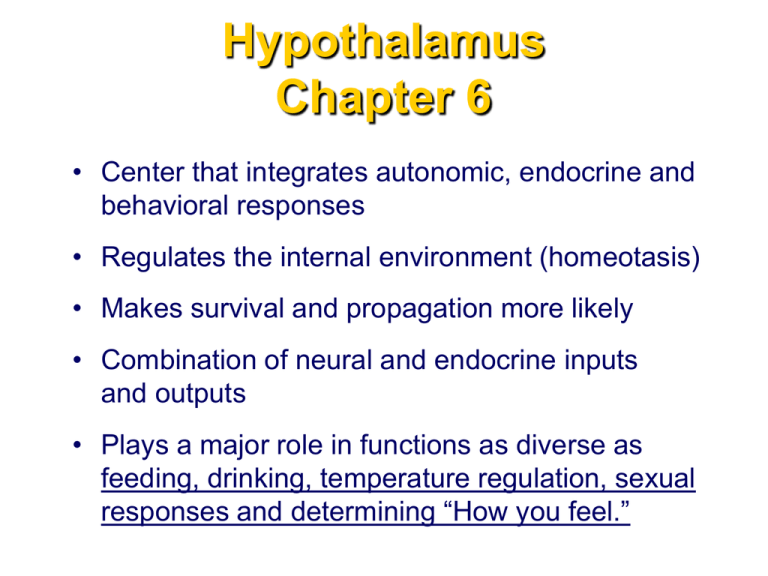
Hypothalamus Chapter 6 • Center that integrates autonomic, endocrine and behavioral responses • Regulates the internal environment (homeotasis) • Makes survival and propagation more likely • Combination of neural and endocrine inputs and outputs • Plays a major role in functions as diverse as feeding, drinking, temperature regulation, sexual responses and determining “How you feel.” Hypothalamus and Homeostasis • Close tolerances necessary for life – Small percentage change in body temperature, electrolytes, and blood pH can cause death • Homeostasis and the internal milieu • Interface between external and internal environment – Endocrine system – Autonomic nervous system Hypothalamic Role in Emotion Visceral Afferents Hypothalamic Nuclei Hormonal Output Nucleus of the Solitary Tract Target Organs Autonomic Output Brain Stem Nuclei Autonomic Preganglionic Nuclei Hypothalamus Pituitary Releasing Factors Adenohypophysis (Anterior Pituitary) Autonomic Nervous System Neurohypophysis (Posterior Pituitary) Sympathetic Parasympathetic “I feel fear!” stria terminalis mtt Cortex, septum Amygdala medial forebrain bundle Anterior Nucleus dorsal long. fasciculus Brainstem medial forebrain bundle Brainstem spinal cord Hypothalamus ventral route ant. Amygdala parvo magno (SO, PV) Pituitary post. stria terminalis mtt Cortex, septum Amygdala medial forebrain bundle Anterior Nucleus dorsal long. fasciculus Brainstem medial forebrain bundle Brainstem spinal cord Hypothalamus ventral route ant. Amygdala parvo magno (SO, PV) Pituitary post. The hypothalamus not only influences how you feel, it influences how you interpret the consequences of those feelings. stria terminalis Physical inputs Cortex, septum Retina humoral, temperature medial forebrain bundle fornix Hippocampal formation dorsal long. fasciculus Brainstem medial forebrain bundle Brainstem spinal cord Hypothalamus optic tract Amygdala Amygdala ventral route Thermo-regulation (body temperature) • Involves autonomic nervous, endocrine, and skeletomotor systems • Body temperature detectors – Peripheral: skin, spinal cord, viscera – Central: anterior hypothalamus • Body temperature effectors – Heat retention or generation: posterior hypothalamus – Heat dissipation: anterior hypothalamus Thermo-regulation (body temperature) • Heat dissipating mechanisms – Dilation of blood vessels in the skin – Inhibition of shivering • Heat conserving mechanisms – Vasoconstriction of blood vessels in the skin – Shivering – Increased secretion of thyroxin Temperature control center. In the mammalian brain, a series of neural pathways (red) control the body’s autonomic responses that regulate heat conservation and production, respectively. Cells in the paraventricular and dorsomedial hypothalamic nuclei, and in the raphe (5HT), signal to sympathetic preganglionic neurons in the spinal cord to control thermogenesis. These pathways are in turn regulated by an inhibitory input (blue) from the medial preoptic hypothalamus that is responsive to preoptic temperature. Thermogenesis is subserved by neural inputs to brown adipose tissue, at least in small mammals, where β3 adrenergic receptors mediate production of uncoupling protein 1 (UCP-1). UCP-1 allows mitochondria in brown adipose tissue to convert adenosine 5'-triphosphate (ATP) to heat, rather than to energy for performing work. Thus, small mammals that lack sufficient mass for heat retention carry portable heaters in the form of brown adipose tissue that allow them to avoid hypothermia. Low body temperature does prolong life span in poikilothermic fish (in which body temperature fluctuates with that of the external environment) Homeotherms with a restricted caloric intake develop a low body temperature and also have a prolonged life span. one might wonder whether 37°C is indeed the optimal body temperature for humans, and why evolution has not selected for a lower body temperature and longer life span. However, there would be little evolutionary pressure to extend the number of years of life after reproduction is finished Response to Cold Response to Heat Methods of thermo-regulation by the body Disorders of Thermo-regulation • Lesions of heat conserving mechanisms – Lesion of posterior hypothalamus – Causes hypothermia • Lesions of heat dissipating mechanisms – Lesion of anterior hypothalamus – Causes hyperthermia • Disconnection syndrome – Thermo-regulator mechanisms separated from effectors • Cannot control skin vasodilatation • Cannot shiver – Causes piokoliothermia Hyperpyrexia • Malignant Hyperthermia – Response to general anesthesia – Associated with neuroleptic medications • Interferes with dopamine function in the hypothalamus – Interference with peripheral heat dissipating mechanism • Anti-cholinergic medications interfere with sweating and heat dissipation Hypothalamus • Center that integrates autonomic, endocrine and behavioral responses • Regulates the internal environment (homeotasis) • Makes survival and propagation more likely • Combination of neural and endocrine inputs and outputs • Plays a major role in functions as diverse as feeding, drinking, temperature regulation, sexual responses (CSF 1%) Thirst • Function of serum osmolality and blood volume • Osmotic receptors in the hypothalamus • Volume receptors in the right atrium of the heart and great veins – Vasopressin release from hypothalamus • Increases water reabsorption from the kidney • Inhibited by ethanol • Neurogenic diabetes insipidus OVLT Two Kinds of Thirst Drinking Behavior • Shorter stay = more drinks/hr • Drinking alone = more drinks/hr • Rhythm that equals the heart rate = more drinking • Lyrics: sad songs = more drinking • More men than women = more drinking • Live band = more drinking • Action photography = more drinking Circadian Rhythm • Oscillations during the course of the day – Corticosteriods – Feeding and drinking behavior – Growth hormone secretion • Lesions of the suprachiasmatic nuclei of the hypothalamus disrupts these oscillations Suprachiasmatic Nucleus Each nucleus contains about 20,000 neurons Biological Clocks May Exist in All Cells of the Body Control of Feeding Feeding • Complex interaction of many systems • Regulation of energy metabolism by the Ventromedial and Lateral nuclei of the hypothalamus – Physical Lesions produce hyperphagia and obesity or reduced attention to food. • Amygdala may also be involved indirectly – Lesions produce hyperphagia-like symptoms • Ventromedial hypothalamic lesions also cause increased insulin secretion Obesity. The Yin and Yang personalities of ghrelin and obestatin. Both hormones derive from the same precursor protein and are predominantly secreted by the stomach and released into the blood. Each acts on a different receptor (GPR39 and GHSR, as shown) and has an opposite effect on food intake, body weight, and gastrointestinal motility. K. SUTLIFF/SCIENCE, 2005 Orexin (hypocretin) neurons: Peyron et al. J. Neurosci. 1998;18:9996-10015 - located only in hypothalamus - widespread projections - mutations produce narcolepsy symptoms - prominent hypothesis: arousal Functionally distinct orexin neuron groups Projections to brainstem arousal areas: •LC •TMN •PPT/LDT Projections to forebrain and midbrain reward areas: •VTA •NAc •Amy LH DMH/PFA Reward-related inputs: •Morphine •Cocaine •Food Arousal-related inputs: •Waking •Stress Basal Metabolic Rate Relation between body size and metabolism Body Weight Probability of dying from any cause Data for 1,000,000 people Effect of caloric intake on: (A)Body weight (B)Percent survival (C)Life-span The potential synergy between diet & exercise could involve common cellular pathways important for neurogenesis, cell survival, synaptic plasticity and vascular function. Optimal maintenance of brain health might depend on exercise and intake of natural products. Van Praag, TINS, 2009 OXYGEN: A Pro-Aging Molecule • The risk is simply being alive, e.g. breathing, eating, exercising… • 2% of oxygen used in energy metabolism forms oxygen free radicals that are toxic and may damage DNA. • The complement of anti-oxidant systems your species possesses is directly related to how long your species lives. Effect of Caloric Restriction on Mice Percent of Mice with Tumors Fewer cancerous tumors among those on restricted diets 50 Normal Diet (control group) Caloric Restrictions 45 40 30 20 10 15 11 9 2.1 0 Hepatoma 1 Lymphoma All Tumors Tumors, including hepatoma (cancer of the liver) and lymphoma (cancer of the lymph system) were fewer in 2-year -old mice on the caloric restriction diet compared to mice on the regular diet. Source: R.T. Bronson and R.D. Lipman, Growth, Development and Aging, 1991. Degenerative Diseases Control Rats vs. Restricted Rats Percent of Rats with Degenerative Disease 100 95 Normal Diet (control group) Caloric Restrictions 80 80 75 55 60 35 40 25 19 20 0 Kidney Muscle 18 Heart Vascular Diaease Type The incidence of degenerative disease of the kidney, muscle, heart, and blood vessels, in 2-year-old rats is higher on regular than on CR diets Source: B.N. Berg, in Hypothalamus, Pituitary and Aging, 1976. Dietary Restriction Obesity: Why do we eat so much? • Evolutionary: the fittest individuals preferred a high calorie diet, ate to capacity, stored excess calories as fat and used those stores as efficiently as possible. • Cultural: 3 meals/day regardless of whether you’re hungry. • Social: high caloric food during gatherings with friends. Obesity: Why do we eat so much? • We live in an environment in which an endless variety of foods of the highest positiveincentive value are readily and continuously available. Reactions to pain were suppressed during chocolate eating Ingestion analgesia functions to defend eating from ending. Humans become hyperphagic when palatable food is readily available suggesting that tasty food within easy reach is destined for defended consumption in humans as well as other animals. Humans eat more when more food is available even when the food is stale or even when they are made cognizant of this tendency . The biological drive to consume palatable foods to completion outweighs opposing cognitive and motivational factors and is likely a major factor in the recent dramatic increase in obesity in modern human societies. Copyright ©2009 Society for Neuroscience Foo, H. et al. J. Neurosci. 2009;29:13053-13062 Obesity • Average quality-of-life rating assigned to U.S. children with cancer: 69 •Average quality-of-life rating assigned to obese children: 67 Obesity Treatment: Less eating or more exercise? • Simple exercise contributes little to weight loss. • Physical activity consumes only a small portion of total energy. • 80% of energy is used to maintain resting physiological processes and to digest food. Obese people have elevated levels of endogenous endocannabinoids The Anti-Cannabinoid Rimonabant Liposuction?
